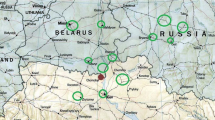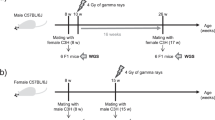Abstract
Genome instability transmission in offspring was analyzed in order to evaluate the risk of delayed genetic effects of exposure in 95 family triplets in which only fathers experienced prolonged occupational radiation exposure. The mean total preconceptive absorbed dose (TPAD) of external gamma radiation in the paternal gonads was 1.65 ± 0.080 Gy (dose range of 0.57–5.70 Gy), and the mean TPAD of internal alpha radiation from incorporated plutonium-239 in the gonads was 0.0015 ± 0.0003 Gy (dose range 0.000–0.015 Gy). The control group consisted of 50 family triplets in which parents were not occupationally exposed. The mutation process was studied using PCR based on hypervariable minisatellite marker CEB1 (chromosome 2, 2q37.3). The paternal type of inheritance of mutations for minisatellite CEB1 was found in 80% of cases. The analysis revealed a statistically significant increase in minisatellite CEB1 mutations in the common group of families in which fathers experienced prolonged occupational radiation exposure and in the group of families in which fathers were exposed to radiation in a dosage range of 0.5–1.0 Gy as compared to the control, reaching a significance level of p = 0.109 and p = 0.058, respectively. The dose threshold of mutation detection in the offspring of Mayak PA workers was estimated.
Similar content being viewed by others
References
Tatsukawa, Y., Cologne, J.B., Hsu, W.L., et al., Radiation risk of individual multifactorial diseases in off-spring of the atomic-bomb survivors: a clinical health study, J. Radiol. Prot., 2013, vol. 33, no. 2, pp. 281–293.
Miller, R.W. and Jablon, S., A search for late radiation effects among men who served as X-ray technologists in the US army during World War II, Radiology, 1970, vol. 96, no. 2, pp. 296–274.
Winther, J.F., Olsen, J.H., Wu, H., et al., Genetic disease in the children of Danish survivors of childhood and adolescent cancer, J. Clin. Oncol., 2012, vol. 30, no. 1, pp. 27–33.
UNSCEAR 2012: Report to the General Assembly, with Scientific Annex “Biological Mechanism of Radiation Action at Low Doses,” New York: United Nations, 2012.
BEIR VII Report 2006, phase 2: Health Risks from Exposure to Low Levels of Ionizing Radiation, Committee to Assess Health Risks from Exposure to Low Levels of Ionizing Radiation, National Research Council.
Dauer, L.T., Brooks, A.L., Noel, D.G., et al., Review and evaluation of updated researches on the health effects associated with low-dose ionizing radiation, Radiat. Prot. Dosim., 2010, vol. 140, no. 2, pp. 103–136.
Patrusheva, N.V. and Doshchenko, V.N., Indicators of physical development in children whose parents worked at radiochemical plant, Byull. Radiat. Med., 1971, no. 1, pp. 107–115.
Voronina, Z.I., Voronin, P.F., Tretyakov, F.D., et al., Some data on physical development of newborns whose parents underwent occupational radiation exposure, Byull. Radiat. Med., 1974, issue 2, no. 4, pp. 115–116.
Voronin, P.F., Voronina, Z.I., Tretyakov, F.D., et al., Assessment of frequency of malformations among the newborns whose parents worked in the nuclear industry, Byull. Radiat. Med., 1974, issue 2, no. 4, pp. 116–117.
Voronina, Z.I., Voronin, P.F., Tretyakov, F.D., et al., Stillbirths among the offspring of nuclear power plant workers, Byull. Radiat. Med., 1974, issue 2, no. 4, pp. 117–118.
Patrusheva, N.V. and Voronin, P.F., Morbidity among the children whose fathers were subjected to occupational irradiation, Byull. Radiat. Med., 1980, no. 1, pp. 30–34.
Buldakov, L.A., Demin, S.N., Koshurnikova, N.A, et al., Radiation safety of the population living in the vicinity of the nuclear plants, At. Energ., 1989, vol. 67, no. 2, pp. 81–83.
Tretyakov, F.D., Voronina, Z.I., Voronin, P.F., and Demin, S.N., The level and structure of infant mortality in the city, located near nuclear plant, Med. Radiol., 1991, vol. 36, no. 7, pp. 7–10.
Petrushkina, N.P., Koshurnikova, N.A., Okatenko, P.V., et al., Infant and perinatal mortality rates in the cohort of the offspring of Mayak workers, Int. J. Low Radiat., 2006, vol. 2, nos. 3–4, pp. 243–256.
Tel’nov, V.I., Kabirova, N.R., and Okatenko, P.V., Carcinogenic risk among the offspring of fathers subjected to chronic preconception irradiation, in Dvadtsat’ pyat’ let Chernobyl’skoi katastrofy: bezopasnost’ budushchego (Twenty-Five Years after the Chernobyl Disaster: Safety for the Future), (Proc. Int. Conf.), Kiev, 2011, part 1, pp. 220–224.
Koterov, A.N. and Biryukov, A.P., Children of liquidators of the Chernobyl nuclear power plant: 1. Evaluation of the principal possibility to register the radiation effects, Med. Radiol. Radiats. Bezop., 2012, vol. 57, no. 1, pp. 5–21.
Durnev, A.D., Zhanataev, A.K., Shreder, O.V., and Seredina, V.S., Genotoxic events and diseases, Mol. Med., 2013, no. 3, pp. 3–19.
Vorobtsova, I.E., Genetic and somatic effects of ionizing radiation in humans and animals (comparative aspects), Radiats. Biol.: Radioekol., 2002, vol. 42, no. 6, pp. 639–643.
Bochkov, N.P. and Durnev, A.D., Mutatsionnyi protsess u cheloveka: nasledstvennye bolezni (Mutation Process in Humans: Hereditary Diseases), Moscow: Geotar-Media, 2012.
Dubrova, Yu.E., Radiation and induction of mutations in human germline cells, Radiats. Biol.: Radioekol., 2006, vol. 46, no. 5, pp. 537–546.
Satoh, C., Takahashi, N., Asakawa, J., et al., Genetic analysis of children of atomic bomb survivors, Envirom. Health Perspect, 1996, vol. 104,suppl. 3, pp. 511–519.
Kodaira, M., Izumi, S., Takahashi, N., and Nakamura, N., No evidence of radiation effect on mutation rates at hypervariable minisatellite loci in the germ cells of atomic bomb survivors, Radiat. Res., 2004, vol. 162, pp. 350–356.
Dubrova, Y.E., Nesterov, V.N., and Krouchinsky, N.G., et al., Human minisatellite mutation rate after the Chernobyl accident, Nature, 1996, vol. 380, pp. 683–686.
Dubrova, Y.E., Nesterov, V.N., Krouchinsky, N.G., et al., Further evidence for elevated human minisatellite mutation rate in Belarus eight years after the Chernobyl accident, Mutat. Res., 1997, vol. 381, pp. 267–278.
Dubrova, Y.E., Grant, G., Chumak, A.A., et al., Elevated minisatellite mutation rate in the post-Chernobyl families from Ukraine, Am. J. Hum. Genet., 2002, vol. 71, pp. 801–809.
Livshits, L.A., Malyarchuk, S.G., Kravchenko, S.A., et al., Children of Chernobyl cleanup workers do not show elevated rates of mutations in minisatellite alleles, Radiat. Res., 2001, vol. 155, pp. 74–80.
Slebos, R.J.C., Little, R.E., Umbach, D.M., et al., Mini- and microsatellite mutations in children from Chernobyl accident clean-up workers, Mutat. Res., 2004, vol. 559, pp. 143–151.
Furitsu, F., Ryo, H., Yeliseeva, K.G., et al., Microsatellite mutations show no increases in the children of the Chernobyl liquidators, Mutat. Res., 2005, vol. 581, pp. 69–82.
Kiuru, A., Auvinen, A., Luokkamaki, M., et al., Hereditary minisatellite mutations among the offspring of Estonian Chernobyl cleanup workers, Radiat. Res., 2003, vol. 159, pp. 651–655.
Ploshchanskaya, O.G., Kozionova, O.S., Akleev, A.V., and Dubrova, Yu.E., Analysis of mutations at minisatellite DNA loci in the Techa River Population, in Khronicheskoe radiatsionnoe vozdeistvie: mediko-biologicheskie effekty (Chronic Radiation Exposure: Medical and Biological Effects), (Proc. 3rd Int. Symp.), Chelyabinsk, 2005, p. 95.
Dubrova, Y.E., Bersimbaev, R.I., Djansugurova, L.B., et al., Nuclear weapons tests and human germline mutation rate, Science, 2002, vol. 295, p. 1037.
Shaikhaev, G.O., Kuz’mina, N.S., Myazin, A.E., et al., The analysis of mutations at miniand microsatellite DNA loci in the family members of a group of occupationally exposed to tritium and tritium oxide plant workers, Radiats. Biol.: Radioekol., 2009, vol. 48, no. 6, pp. 690–697.
Tel’nov, V.I., Evaluation of mutation rate in the germ cells of humans exposed to radiation (review of the literature and private data), Vopr. Radiats. Bezop., 1999, no. 4, pp. 59–65.
Bezlepkin, V.G., Kirillova, E.N., Zakharova, M.L., et al., Delayed and transgenerational molecular and genetic effects of prolonged influence of ionizing radiation in nuclear plant workers, Radiats. Biol.: Radioekol., 2011, vol. 51, no. 1, pp. 20–32.
Vergnaud, G. and Denoeud, F., Minisatellites: mutability and genome architecture, Genome Res., 2000, no. 10, pp. 899–907.
Jeffreys, A.J., Tamaki, K., and MacLeod, A., et al., Complex gene conversion events in germline mutation at human minisatellites, Nat. Genet., 1994, vol. 6, pp. 136–145.
Buard, J., Shone, A.C., and Jeffreys, A.J., Meiotic recombination and flanking marker exchange at the highly unstable human minisatellite CEB1 (D2S90), Am. J. Hum. Genet., 2000, vol. 67, no. 2, pp. 334–344.
Rusinova, G.G. and Tel’nov, V.I., A DNA bank of irradiated people and the members of their families: prospects for molecular genetic studies, Med. Radiol. Radiats. Bezop., 2005, vol. 50, no. 6, pp. 33–40.
Rusinova, G.G., Glazkova, I.V., Gur’yanov, M.Yu., and Azizova, T.V., A DNA bank of irradiated people and the members of their families: motives for creating, Med. Ekstremalnykh Situatsii, 2010, no. 1, pp. 93–100.
Azizova, T.V., Sumina, M.V., Belyaeva, Z.D., et al., The structure and characteristics of the “Clinic” medical and dosimetric database, Vopr. Radiats. Bezop., 2006, special issue 2, pp. 55–65.
Technical instruction to the Long PCR System kit, Thermo Scientific Corporation, 2006.
Bouffler, S.D., Bridges, B.A., Cooper, D.N., et al., Assessing radiation-associated mutational risk to the germline: repetitive DNA sequences as mutational targets and biomarkers, Radiat. Res., 2006, no. 165, pp. 249–268.
Borovikov, V., STATISTICA: Iskusstvo analiza dannykh na komp’yutere dlya professionalov (STATISTICA: The Art of Computer Data Analysis for Professionals), St. Petersburg: Piter, 2003.
Aivazyan, S.A., Prikladnaya statistika (Applied Statistics), Moscow: Finansy i Statistika, 1983, vol. 1.
Johnson, N.L., Kots, S., and Balakrishnyan, N., Continuous Univariate Distributions, New York: Wiley, 1995, vol. 1, 2nd ed.
Koterov, A.N., The history of ideas about the genome instability at low doses of radiation: the scientific point is probably set, Med. Radiol. Radiats. Bezop., 2014, vol. 59, no. 1, pp. 5–19.
Hemleben, V., Beridze, T., Bachmann, L., et al., Satellite DNAs, Usp. Biol. Khim., 2003, vol. 43, pp. 267–306.
Hannan, A.J., Tandem repeat polymorphisms: mediators of genetic plasticity, modulators of biological diversity and dynamic sources of disease susceptibility, Adv. Exp. Med. Biol., 2012, vol. 769, pp. 1–9.
Sasina, L.K., Slonimskaya, N.A., Suchkova, I.O., et al., Human intra-intronic minisatellite UPS29 associated with neurological diseases regulates reporter gene EGFP expression depending on cell type, Tsitologiya, 2010, vol. 52, no. 9, pp. 715–723.
Bianchi, M., Crinelli, R., Giacomini, E., et al., A potent enhancer element in the 5b-UTR intron is crucial for transcriptional regulation of the human ubiquitin C gene, Gene, 2009, vol. 448, pp. 88–101.
Georges, A.B., Benayoun, B.A., Caburet, S., and Veitia, R.A., Generic binding sites, generic DNA-binding domains: where does specific promoter recognition come from?, FASEB J., 2010, vol. 24, no. 2, pp. 346–356.
Piazza, A., Serero, A., Boule, J.-B., et al., Stimulation of gross chromosomal rearrangements by the human CEB1 and CEB25 minisatellites in Saccharomyces cerevisiae depends on G-quadruplexesor Cdc13, PLoS Genet., vol. 8, no. 11. e1003033. doi:10.1371/journal.pgen.1003033
Xia, X., Rui, R., Quan, S., et al., MNS16A tandem repeats minisatellite of human telomerase gene and cancer risk: a meta-analysis, PLoS One, 2013, vol. 8, no. 8. e73367. doi:10.1371/journal.pone.0073367
Haddley, K., Vasiliou, A.S., Ali, F.R., et al., Molecular genetics of monoaminotransporters: relevance to brain disorders, Neurochem. Res., 2008, vol. 33, pp. 652–667.
Hannan, A.J., Tandem repeat polymorphisms: modulators of disease susceptibility and candidates for missing heritability, Trends Genet., 2010, vol. 26, pp. 59–65.
Niwa, O. and Kominami, R., Untargeted mutation of the maternally derived mouse hypervariable minisatellite allele in Fl mice born to irradiated spermatozoa, Proc. Natl. Acad. Sci. U.S.A., 2001, no. 98, pp. 1705–1710.
Marchetti, F., Essers, J., Kanaar, R., and Wyrobek, A.J., Disruption of maternal DNA repair increases spermderived chromosomal aberrations, Proc. Natl. Acad. Sci. U.S.A., 2007, vol. 104, no. 45, pp. 17725–17729.
Hatch, T., Derijck, A.A., Black, P.D., et al., Maternal effects of the scid mutation on radiation-induced trans-generational instability in mice, Oncogene, 2007, vol. 26, no. 32, pp. 4720–4724.
Author information
Authors and Affiliations
Corresponding author
Additional information
Original Russian Text © G.G. Rusinova, I.V. Glazkova, T.V. Azizova, S.V. Osovets, N.S. Vyazovskaya, 2014, published in Genetika, 2014, Vol. 50, No. 11, pp. 1354–1362.
Rights and permissions
About this article
Cite this article
Rusinova, G.G., Glazkova, I.V., Azizova, T.V. et al. Analysis of genome instability in offspring of Mayak workers’ families: Minisatellite CEB. Russ J Genet 50, 1200–1207 (2014). https://doi.org/10.1134/S102279541411012X
Received:
Published:
Issue Date:
DOI: https://doi.org/10.1134/S102279541411012X




